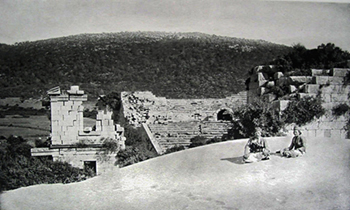Theatre


Located on the northern slope of Kurşunlutepe at the southern end of the city of Patara, the Theatre has a cavea with a diameter of 80 meters exceeding a semicircle and has a capacity of approximately 6000 people. The cavea is divided in two by a diazoma. The cavea, which has a total of 34 rows of seats, 14 at the top and 20 at the bottom, is divided into eight sections (kerkides) by nine staircases leading up from the orchestra. It is believed that the limestone seats lined up along the banks of the Diazoma were reserved for the city's dignitaries. At the top of the cavea (summa cavea), right on the central axis, there is a temple that must have been dedicated to the cult of a god or emperor; however, only a few rows of blocks have survived on the lower level of this building.
The stage building is 41.50 meters long and 6.50 meters deep, free-standing and built on two levels with a hyposkenion (under stage) below. The entrance to the orchestra between the stage building and the cavea is provided by two side passages and a door in the middle of the facade of the stage building. This facade is a unique example of theatrical architecture with its lively architecture and ornamental elements such as columns.
The origin of the theater dates to the Hellenistic Period and the Polyperkhon inscription reveals that the building was repaired during the reign of Emperor Tiberius. According to the monumental inscription on the eastern façade, the construction of the stage building was started in 126 AD by Q. Vilius Titianus in 126 AD, and the construction was completed by his daughter Vilia Procula in 147 AD. In the same period, a citizen of Patara named Tib. Claudius Flavianus Eudemos built the upper part of the cavea, the corner supporting towers and the temple.
In the Late Antique period, a high wall built with spolia was added between the seating rows and the orchestra. This arrangement indicates that gladiator and wild animal fights were held in the orchestra of the theater.
%20sb-crop-u218259.jpg?crc=4273271328)
395x210.jpg?crc=206163109)


<
%20sb60x54.jpg?crc=216828452)
VERBA VOLANT, SCRIPTA MANENT
Theatre
Theatre
Theatre
>
All works (text, images, visuals, photos, videos) featured on this website are related to the Patara excavations and are protected under the Law on Intellectual and Artistic Works no. 5846 and the Turkish Penal Code no. 5237. Their contents cannot be reproduced, even with citation, without permission. They cannot be copied unlawfully or published elsewhere without authorization. Those who violate these rights will be subject to the legal and penal sanctions outlined in the Law on Intellectual and Artistic Works no. 5846 and the Turkish Penal Code no. 5237.
© Copyright PataraKazıları 1988
Web Designer Mustafa AĞGÜL
